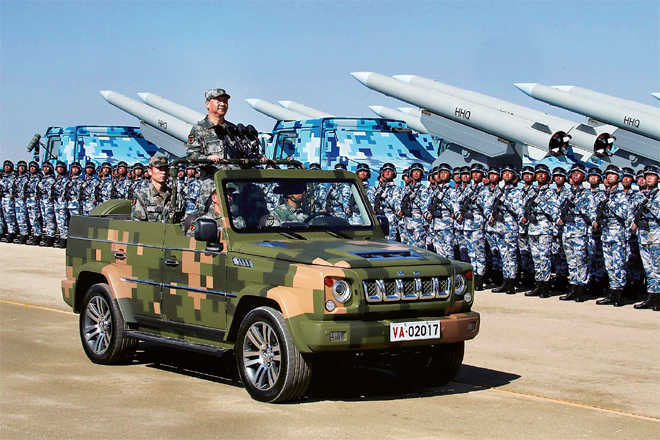
Bhartendu Kumar Singh
Indian Defence Accounts Service
Until a few years back, China's defence budget was eagerly awaited and reacted upon. However, of late, international reactions have been muted - like when China recently declared its defence budget for 2018 at $175 billion, up by 8.1 per cent over the 2017 figures. The single-digit growth rate has been there for three years, departing from the days of double-digit growth year after year. The absence of major reactions notwithstanding, China's defence budget still remains mystery for outside world and needs to be decoded properly.
China's defence budget's justifications as 'conservative' and 'defensive' are based on shaky platforms. China claims that it accounts for just one-fourth of the US military spending. This has been the core polemics and not long back, China was estimated to spend anywhere between two and three times of its official figures. Consistent efforts by international community ensured more transparency and reforms in China's defence budget administration, accounting and reporting, thereby, reducing the gap between the competing claims.
However, the 'veil of ignorance and mystery' continues to define Chinese defence budget and there are simply no takers for its official figures. By all estimates, China still spends much more than it reflects.
China's other claim that many other countries have faster defence budget growth ignores it own double-digit growth for almost two decades until 2013. China could again resort to such a trend in future.
Similarly, China's claims that it lags behind major countries on per capita military expenditure has no takers since reputed annual publications, like the Military Balance (published by the International Institute for Strategic Studies, London), have been publishing year after year all aspects of Chinese defence expenditure, along with that of other countries. Many countries spend much less than China on a per capita basis. India, for example, spends roughly one-third of Chinese per capita figures.
China's conservative declarations on defence spending notwithstanding, estimating its correctness is a futile exercise without reflecting the appropriate military standing of China. One example would suffice. Most attempts towards military strength index place Russia marginally ahead of China. However, China has already emerged as the most important military power after the US. Most importantly, it is closing in on the US and would surely even up by 2050. This leapfrogging is not possible without massive investments in military modernisation. China, therefore, indulges into cross-subsidisation of its defence budget. Perhaps, this speaks why it is placed in low transparency category (category 5) of defence budget by Transparency International, a global NGO.
The higher side of the defence budget can be ascertained in several ways:
1 First, many economic aspects of the defence modernisation process have changed in last two decades. For example, the guns vs butter debate is no more contextual in China's case. Given the huge economic base, even single-digit growth rate translates into a huge budgetary amount for the Chinese PLA. So, the PLA does not mind preferential treatment to developmental priorities, like the eighties and early nineties. Similarly, technology and arms imports have dropped down; decades of techno-nationalism have, instead, ensured that China is exporting them to earn foreign exchange and diplomatic influence.
2 Second, China has established self-sufficiency in most areas of weapons production. China's domestic military-industrial complex (MIC) is producing artillery guns, fighter jets, tanks, submarines, ships and has a steady going project on domestic aircraft carrier. Xi Jinping has long-term plans to facilitate China's leadership in strategic areas of weapons production, dual-use systems, high technology and advanced manufacturing. Moving beyond the realm of state-led growth, Xi is also encouraging private sector participation to plug the loopholes in financial and technological gaps in domestic arms production.
3 Third, China has effected a transformation of the PLA: from being a manpower-oriented army capable of defending at best continental interests to a lean, thin and technology savvy army. It has undergone a complete change of command and control system through the establishment of a 'theatre command system' on the US pattern and is shedding extra manpower. The blue water capacity is now within reach and China is engaging foreign armies in more than 150 joint exercises every year. China has also established lead in aerospace and cyber command, something still beyond the reach of many aspiring great powers.
The impact of Chinese investments in military modernisation is visible in its approach towards neighbours, far-off countries and great powers. China is indulging in offensive realism and aggressive strategic culture, as is evident in South China Sea and the Indo-Pacific region. The US' National Security Strategy (December 2017) named China as a revisionist power and placed it as a central threat along with Russia. A February testimonial before the US China Economic and Security Review Commission highlights how the Chinese PLA is challenging the US in its Pacific Command Operations and elsewhere. Other great powers are also feeling the heat of China's military power projection in Asia and Africa. Such a forceful power projection is not possible through the official budget alone! It is debatable if China would ever usher in defence budget transparency as per international benchmarks. Therefore, more investment is needed in studying Chinese defence modernisation trends, its strategic arsenals, and above all, its posturing on major issues challenging Asian security.
(Views are personal)



























